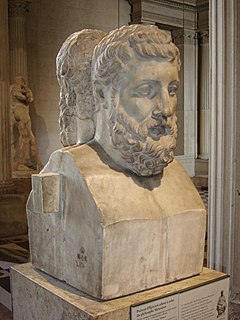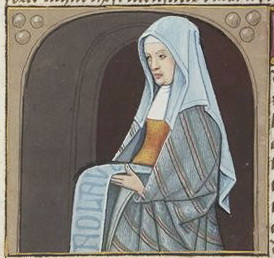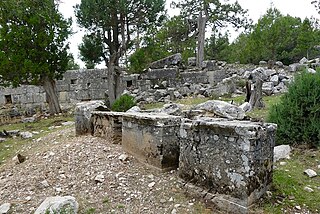Related Research Articles

Epicurus was an ancient Greek philosopher and sage who founded Epicureanism, a highly influential school of philosophy. He was born on the Greek island of Samos to Athenian parents. Influenced by Democritus, Aristippus, Pyrrho, and possibly the Cynics, he turned against the Platonism of his day and established his own school, known as "the Garden", in Athens. Epicurus and his followers were known for eating simple meals and discussing a wide range of philosophical subjects. He openly allowed women and slaves to join the school as a matter of policy. Epicurus is said to have originally written over 300 works on various subjects, but the vast majority of these writings have been lost. Only three letters written by him—the letters to Menoeceus, Pythocles, and Herodotus—and two collections of quotes—the Principal Doctrines and the Vatican Sayings—have survived intact, along with a few fragments of his other writings. Most knowledge of his teachings comes from later authors, particularly the biographer Diogenes Laërtius, the Epicurean Roman poet Lucretius and the Epicurean philosopher Philodemus, and with hostile but largely accurate accounts by the Pyrrhonist philosopher Sextus Empiricus, and the Academic Skeptic and statesman Cicero.

Epicureanism is a system of philosophy founded around 307 BC based upon the teachings of the ancient Greek philosopher Epicurus. Epicureanism was originally a challenge to Platonism. Later its main opponent became Stoicism.

Gaius Cassius Longinus, often referred to as simply Cassius, was a Roman senator and general best known as a leading instigator of the plot to assassinate Julius Caesar on 15 March 44 BC. He was the brother-in-law of Brutus, another leader of the conspiracy. He commanded troops with Brutus during the Battle of Philippi against the combined forces of Mark Antony and Octavian, Caesar's former supporters, and committed suicide after being defeated by Mark Antony.
Diogenes Laërtius was a biographer of the Greek philosophers. Nothing is definitively known about his life, but his surviving Lives and Opinions of Eminent Philosophers is a principal source for the history of ancient Greek philosophy. His reputation is controversial among scholars because he often repeats information from his sources without critically evaluating it. He also frequently focuses on trivial or insignificant details of his subjects' lives while ignoring important details of their philosophical teachings and he sometimes fails to distinguish between earlier and later teachings of specific philosophical schools. However, unlike many other ancient secondary sources, Diogenes Laërtius generally reports philosophical teachings without attempting to reinterpret or expand on them, which means his accounts are often closer to the primary sources. Due to the loss of so many of the primary sources on which Diogenes relied, his work has become the foremost surviving source on the history of Greek philosophy.

Pierre Gassendi was a French philosopher, Catholic priest, astronomer, and mathematician. While he held a church position in south-east France, he also spent much time in Paris, where he was a leader of a group of free-thinking intellectuals. He was also an active observational scientist, publishing the first data on the transit of Mercury in 1631. The lunar crater Gassendi is named after him.

Metrodorus of Lampsacus was a Greek philosopher of the Epicurean school. Although one of the four major proponents of Epicureanism, only fragments of his works remain. A Metrodorus bust was found in Velia, slightly different modeled to depict Parmenides.
Zeno of Sidon was a Greek Epicurean philosopher from the Seleucid city of Sidon. His writings have not survived, but there are some epitomes of his lectures preserved among the writings of his pupil Philodemus.

Hermarchus or Hermarch, sometimes incorrectly written Hermachus, was an Epicurean philosopher. He was the disciple and successor of Epicurus as head of the school. None of his writings survives. He wrote works directed against Plato, Aristotle, and Empedocles. A fragment from his Against Empedocles, preserved by Porphyry, discusses the need for law in society. His views on the nature of the gods are quoted by Philodemus.
Catius was an Epicurean philosopher, identified ethnically as an Insubrian Celt from Gallia Transpadana. Epicurean works by Amafinius, Rabirius, and Catius were the earliest philosophical treatises written in Latin. Catius composed a treatise in four books on the physical world and on the highest good. Cicero credits him, along with the lesser prose stylist Amafinius, with writing accessible texts that popularized Epicurean philosophy among the plebs, or common people.

Leontion was a Greek Epicurean philosopher.

The Tetrapharmakos (τετραφάρμακος) "four-part remedy" is a summary of the first four of the Κύριαι Δόξαι in Epicureanism, a recipe for leading the happiest possible life. They are recommendations to avoid anxiety or existential dread.

Diogenes of Oenoanda was an Epicurean Greek from the 2nd century AD who carved a summary of the philosophy of Epicurus onto a portico wall in the ancient Greek city of Oenoanda in Lycia. The surviving fragments of the wall, originally extended about 80 meters, form an important source of Epicurean philosophy. The inscription, written in Greek, sets out Epicurus' teachings on physics, epistemology, and ethics. It was originally about 25,000 words long and filled 260 square meters of wall space. Less than a third of it has been recovered.
This page is a list of topics in ancient philosophy.
Dionysius of Lamptrai was an Epicurean philosopher, who succeeded Polystratus as the head (scholarch) of the Epicurean school at Athens c. 219 BC. He died c. 205 BC and was succeeded by Basilides.
Basilides was an Epicurean philosopher, who succeeded Dionysius of Lamptrai as the head of the Epicurean school at Athens. c. 205 CE. It is not certain who succeeded Basilides: Apollodorus is the next Epicurean leader we can be certain about, but there may have been at least one intermediate leader, and the name Thespis has been suggested. Barnes and Brunschwig suggested that Basilides of Tyre and Basilides the Epicurean could be the same Basilides.
Nausiphanes, a native of Teos, was attached to the philosophy of Democritus. He was a pupil of Pyrrho and a teacher to Epicurus, who was dissatisfied with him.
On Nature is the name of a philosophical treatise written by the Ancient Greek philosopher Epicurus, which can be considered his main work. The work comprised 37 books and consisted of lectures given by Epicurus.
Epicurus' Letter to Herodotus was written as an introduction to Epicurean philosophy and method of studying nature. It was so important that it was considered the “Little Epitome”, and had to be studied initially by all serious students of Epicureanism.
Eikas, Eikadenfest is a holiday celebrated among Epicureans in commemoration of Epicurus and Metrodorus. It is a monthly celebration taking place on the 20th day of every month. The observance was made during Epicurus' lifetime, and provisions were made in his will to continue the practice. It became so characteristic of the Epicureans that they were given the nickname Twentiers (eikadistae) by detractors. It was also used as a means of recruitment for new students into the Epicurean school, as the Garden was opened for participation in the festivities.
The Principal Doctrines are forty authoritative conclusions set up as official doctrines by the founders of Epicureanism: Epicurus of Samos, Metrodorus of Lampsacus, Hermarchus of Mitilene and Polyaenus of Lampsacus. The first four doctrines make up the Tetrapharmakon, which have sometimes been compared to Buddhism's Four Noble Truths. They are often cited as "PDs" in English.
References
- ↑ "Epicurus: Letter to Menoeceus (Summary)". The-Philosophy. Retrieved 2018-12-21.